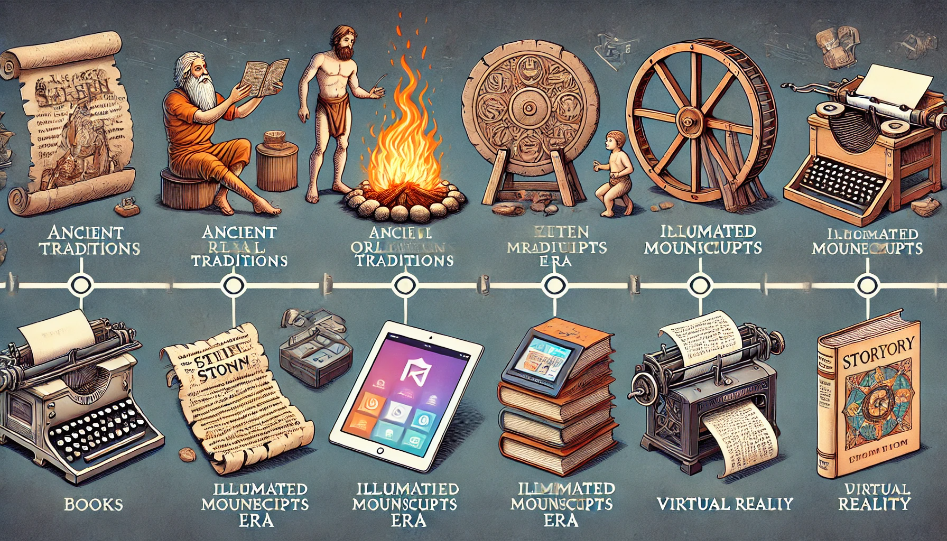The Evolution of Storytelling: A Timeline of Writing Stories
-
Richard Pen
| Tuesday 9th of July 2024 12:51:22 AM (UTC)

Introduction
Storytelling is an ancient art that has evolved over millennia, adapting to cultural shifts and technological advancements. The journey from oral traditions to digital narratives is a fascinating one, reflecting humanity's unending desire to communicate and share experiences. This article delves into the timeline of writing stories, tracing its development from the earliest forms to contemporary practices.
Ancient Beginnings
Oral Traditions
Before the advent of written language, storytelling was primarily oral. Tales were passed down through generations by word of mouth, often taking the form of myths, legends, and folklore. These stories served to preserve history, impart moral lessons, and entertain.
The Birth of Writing
Around 3200 BCE, the Sumerians of Mesopotamia developed cuneiform, one of the earliest known writing systems. This invention marked the beginning of written storytelling. Early writings were inscribed on clay tablets and included myths like the Epic of Gilgamesh, one of the oldest known literary works.
Classical Antiquity
Egyptian Hieroglyphs and Greek Epics
By 3000 BCE, the Egyptians had developed hieroglyphs, which were used to record a variety of texts, including stories and religious texts. Meanwhile, in Greece, the oral tradition continued, culminating in the epic poems of Homer. "The Iliad" and "The Odyssey," written around the 8th century BCE, are monumental works that have influenced storytelling for centuries.
Roman Influence
The Romans, influenced by Greek literature, contributed significantly to storytelling. Writers like Virgil, with his epic "The Aeneid," and Ovid, known for "Metamorphoses," expanded the literary tradition, blending myth and history in their narratives.
The Middle Ages
Monastic Scribes and Religious Texts
During the Middle Ages, monasteries became centers of learning and storytelling. Monastic scribes meticulously copied religious texts, and illuminated manuscripts became a significant art form. The "Beowulf" manuscript, dating from around the 8th century, is a notable example of early medieval literature.
The Rise of Chivalric Romance
The 12th and 13th centuries saw the rise of chivalric romance, with tales of knights, love, and adventure. Works like "The Song of Roland" and "Sir Gawain and the Green Knight" exemplify this genre, blending heroic feats with moral lessons.
The Renaissance
Printing Revolution
The invention of the printing press by Johannes Gutenberg in the mid-15th century revolutionized storytelling. Books became more accessible, leading to an explosion of literature. The Renaissance period saw the publication of works like Dante's "Divine Comedy" and Chaucer's "The Canterbury Tales," which explored human nature and social commentary through storytelling.
Shakespeare and the English Renaissance
William Shakespeare, perhaps the most influential storyteller of the Renaissance, wrote plays and sonnets that delved into the complexities of the human condition. His works, such as "Hamlet" and "Macbeth," continue to be celebrated for their narrative depth and character development.
The Enlightenment and Romantic Era
Novels and Individualism
The 18th century ushered in the novel as a dominant literary form. Writers like Daniel Defoe ("Robinson Crusoe") and Jonathan Swift ("Gulliver's Travels") created stories that focused on individual experiences and societal critique.
Romanticism
The late 18th and early 19th centuries saw the rise of Romanticism, which emphasized emotion, nature, and individualism. Authors like Mary Shelley ("Frankenstein") and the Brontë sisters ("Wuthering Heights" and "Jane Eyre") crafted stories that explored inner turmoil and the sublime in nature.
The Victorian Era and Early 20th Century
Serial Publications
The Victorian era was marked by the popularity of serialized novels. Authors like Charles Dickens published their works in installments, making literature more accessible to the masses. "Great Expectations" and "A Tale of Two Cities" are exemplary works from this period.
Modernism and Experimental Narratives
The early 20th century introduced modernism, characterized by experimental narratives and a focus on stream of consciousness. Writers like James Joyce ("Ulysses") and Virginia Woolf ("Mrs. Dalloway") pushed the boundaries of storytelling, exploring fragmented realities and inner consciousness.
Contemporary Storytelling
Digital Revolution
The digital age has transformed storytelling once again. The advent of the internet and digital publishing has democratized literature, allowing authors to reach global audiences with ease. E-books, audiobooks, and online platforms like Wattpad and Kindle Direct Publishing have revolutionized how stories are written and consumed.
Interactive and Multimedia Narratives
Today, storytelling extends beyond traditional formats. Interactive narratives, such as video games and virtual reality experiences, offer immersive story worlds. Multimedia storytelling, combining text, audio, and visual elements, creates dynamic and engaging narratives.
Related Articles
For more insights into the evolution of storytelling in modern media, read "Modern Storytelling: Film, Television, and Digital Media" .
Explore the impact of traditional narratives on contemporary culture in "Folktales and Fairy Tales: The Timeless Stories That Shape Cultures".
Conclusion
The timeline of writing stories is a testament to humanity's enduring need to share experiences, impart knowledge, and entertain. From ancient oral traditions to contemporary digital narratives, storytelling continues to evolve, reflecting the changing landscapes of culture and technology. As we move forward, the art of storytelling will undoubtedly adapt, offering new ways to connect and inspire future generations.
Start the conversation
Become a member of TxtTale to start commenting.
Already a member?
